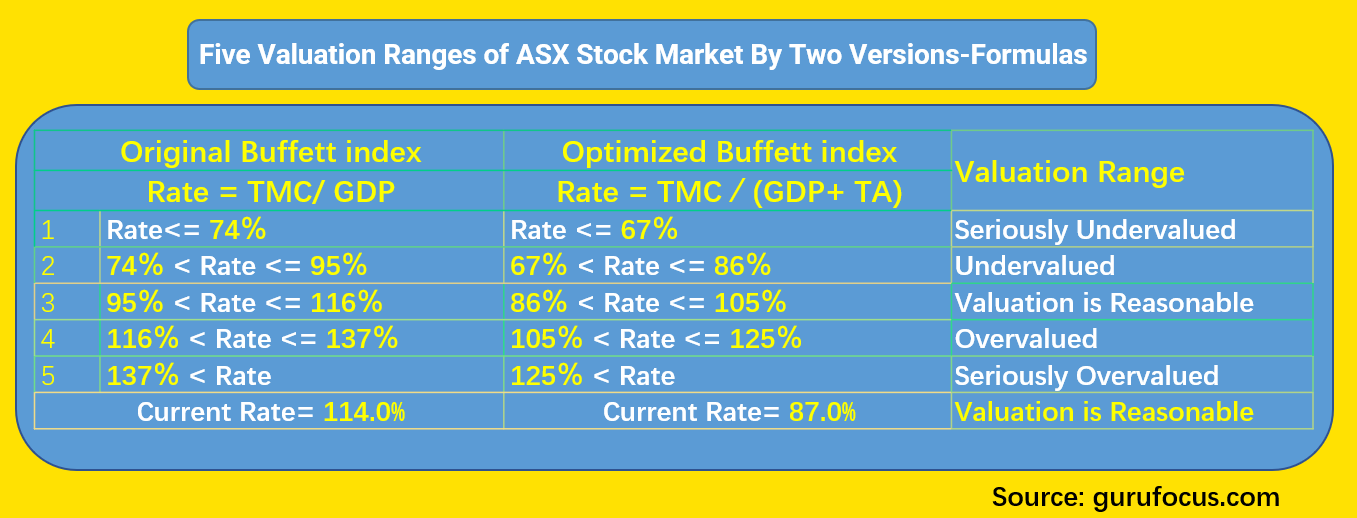Universal Valuation Formula: AU Stock Market's Return can be Expected
In December 2001, Buffett mentioned in an article that the ratio of the Total Market Value of the U.S. stock market ((Wilshire 5000 index)) to GDP can be used to judge whether the current stock market (U.S. stocks) is overheated. This index is called the Buffett index. Buffett once described this index as "the only best index to measure the stock market valuation at any time".
Buffett said "when this ratio is between 70% and 80%, buying stocks is likely to bring you good returns. If this index is close to 200%, for example, in 1999 and part of 2000, you are playing with fire."
The Wilson 5000 index currently covers more than 7500 stocks. Due to its wide coverage, many US investors call the index the "total market index". The Wilson 5000 index is currently the largest in the world.
This indicator tells you that when stocks market valuation is high, you should allocate more bonds and less stocks. When the market is balanced, stocks and bonds will be evenly distributed.
You just need to continue to buy when judging that the market is undervalued and sell when it is extremely overvalued, so you can get higher than the average return of the market.
Based on this index, Let‘s calculate the valuation of the Australian stock market.
Cite the dynamic tracking of gurufocus, we sorted out the different rates of return under the calculation of the original Buffett index and the optimized Buffett index.
Based on the original Buffett index TMC / GDP, the valuation of the Australian stock market is within a reasonable range, and the market expects an annualized return of + 5.4% in the next 8 years.
Based on the optimized Buffett index TMC / (GDP + TA), the valuation of the Australian stock market is within a reasonable range, and the market expects an annualized return of + 7.6% in the next 8 years.
The specific relevant data in the formula are as follows:
Total market value (TMC) is standardized using the Australian $S&P/ASX 200(XJO.AU)$ index using data released by the World Bank. Australia's total historical market value (TMC) is in trillions, denominated in local currency.
Australia's current annual gross domestic product (GDP) is 2.00 trillion local currency, equivalent to 1.39 trillion US dollars; In terms of local currency, the annual growth rate of GDP = 2.79%.
The current total assets (TA) of the Central Bank of Australia is 0.621 trillion local currency, equivalent to US $0.432 trillion.
Comparison of valuation calculated by two formulas:
The two versions of formulas that dividend the Australian stocks into five valuation ranges respectively.
According to the valuation stratification of the chart, as of the time of publication, after the calculation of the two versions of indicators, Australian stocks are within a reasonable valuation range.
The original Buffett index is expected to have an annualized return of + 5.4% in the next eight years, and the optimized Buffett index is expected to have an annualized return of + 7.6% in the next eight years.
If you have confidence in the index investment of Australian stocks, you can learn more about the ETF investing in Australian stocks.
Disclaimer: Investing carries risk. This is not financial advice. The above content should not be regarded as an offer, recommendation, or solicitation on acquiring or disposing of any financial products, any associated discussions, comments, or posts by author or other users should not be considered as such either. It is solely for general information purpose only, which does not consider your own investment objectives, financial situations or needs. TTM assumes no responsibility or warranty for the accuracy and completeness of the information, investors should do their own research and may seek professional advice before investing.

@ASX_Stars Thanks for your excellent analysis of the valuation of Australian stocks. It is good to know that they are in the reasonable valuation range. I am certainly keen to invest in Aussie stocks as they pay better dividends than the US stocks. They also provide a good diversification in my portfolio. Stocks like $BHP GROUP LTD(BHP.AU)$ pay a juicy dividends of 10.5% yield too.
估值重要‼️